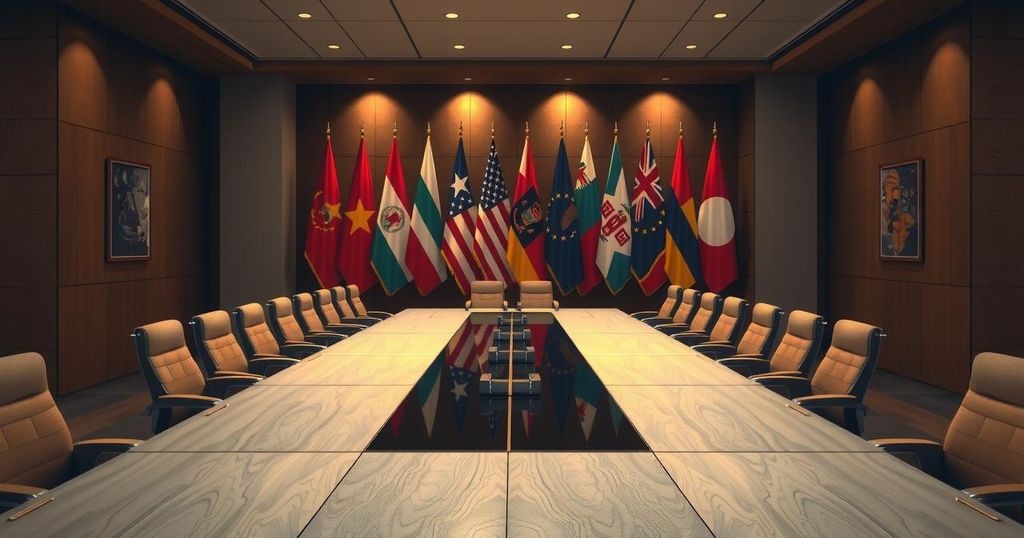China’s Transformation from Courting Trump to Defiant Resistance in Trade
China has shifted from trying to court President Trump to a hardline trade stance, enforcing a ‘wartime footing’ among government officials and rallying international support against U.S. tariffs. Chinese leaders are asserting their position through propaganda and diplomatic letters, emphasizing that the trade war initiated by the U.S. requires dialogue based on equality. The situation reflects a marked departure from initial diplomatic channels and ongoing attempts to retaliate and bolster domestic economic resilience amidst external challenges.
Following unsuccessful attempts to foster a favorable relationship with President Donald Trump, China has adopted a stringent stance regarding trade issues. The Chinese government has prompted foreign affairs and commerce officials to suspend vacations, initiating a ‘wartime footing’ to counteract U.S. tariffs. In this campaign, Chinese propaganda officials have utilized historical messages, evoking defiance by quoting former leader Mao Zedong: “we will never yield.” Bureaucrats in critical governmental departments are on alert and accessible at all times, reflecting a significant shift in China’s diplomatic strategy.
Initially, China sought to prevent an escalating trade war with the Trump administration, establishing communication channels in pursuit of a mutually beneficial relationship. Optimistic observers believed in the possibility of a grand trade deal, but that optimism has since faded. China’s current defiant response entails retaliatory tariffs, vigorous diplomatic engagements with other nations affected by U.S. tariffs, and a redoubled effort to frame its position in international dialogues.
This transition is marked by the Chinese government’s assertion that it is a responsible global player resisting hegemony while safeguarding its interests. The Chinese foreign ministry stated, “This trade war was started by the U.S. and imposed on China… If the U.S. really wants to resolve the issue through dialogue and negotiations, it should stop applying extreme pressure.”
In the aftermath of initial tariffs imposed by Trump, which were viewed as an aggressive measure, he accused China of panicking. Trump highlighted that the situation reflects a contentious climate where U.S. officials attributed the stalemate to China’s significant trade surplus, claiming it stems from systemic commerce abuses.
Although Trump’s presidency began with a cordial invitation extended to Xi Jinping, diplomatic relations quickly soured. Key communication channels that characterized the former administration have diminished, leaving uncertainty about who currently represents U.S. interests in talks with China. A notable absence of shared discussions has persisted under President Biden, despite some preliminary talks through intermediaries aiming to renew dialogues on trade issues.
China’s response strategy has evolved by incorporating lessons from previous trade disputes, thereby establishing a retaliatory framework that includes tariffs and various trade restrictions. In a decisive move, China responded with comprehensive levies soon after the initiation of Trump’s tariffs, underscoring its determination to resist U.S. pressure during this heightened volatility in international trade dynamics.
Despite persistent diplomatic efforts, such as reaching out to G20 nations for a collective stance on multilateral trade agreements, China faces significant criticism regarding its trade practices and industrial policies. As domestic sentiments regarding tariffs gain traction, the Chinese government reacts by promoting consumer spending, reflecting a strategic pivot aimed at internal economic resilience amidst external pressures.
Thus, China is placing greater emphasis on domestic economic strategies rather than solely engaging in bilateral negotiations with the U.S. Current efforts illustrate a desire to bolster its internal market, underscoring the sentiment that “the real battlefield is on the domestic front, rather than bilateral negotiations.”
In a show of solidarity and determination, the Chinese foreign ministry has convened meetings with heads of its overseas missions to ensure a unified response to external pressures. Through outreach, China aims to foster multilateral support while defending its national interests strategically on both domestic and international fronts, aligning with past historical narratives of resilience.
Signs of enduring defiance echo through history, as leadership messages emphasize the resolute stance of not yielding under pressure. Chairman Mao Zedong’s quote, now repurposed, resonates strongly within the current context, embodying an enduring spirit of resistance. The long-term strategy reveals complexities in global trading relations, a mechanism that continues to shape the intense dialogue between the U.S. and China.
In conclusion, China’s transition from seeking accommodation with the Trump administration to adopting a defiant posture signifies a pivotal moment in international trade relations. Through a coordinated ‘wartime footing,’ diplomatic outreach, and firm domestic policies, China is fortifying its position against U.S. tariffs. The historical resonance of Mao Zedong’s defiant spirit underlines the Chinese resolve to persist in the face of external pressures. The ongoing developments indicate a pronounced focus on internal economic strength and multilateral collaboration as essential strategies for navigating contemporary trade challenges.
Original Source: www.usatoday.com




Post Comment